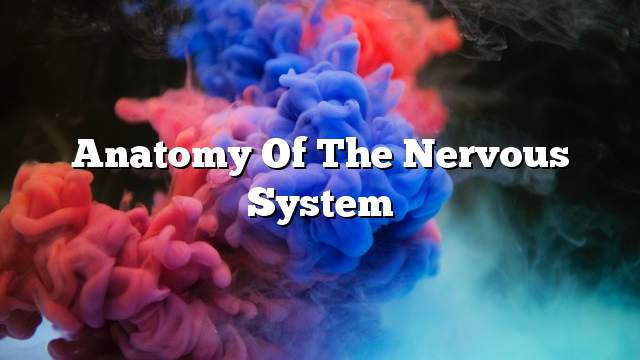The nervous system is an internal communication network in the animal’s body that helps it adapt to environmental changes. Each animal, except simple primary animals, has a kind of nervous system. This is the dissection of this device.
Central nervous system : It consists of the brain and spinal cord. The control center acts on the nervous system. The central nervous system receives information from the senses. It analyzes this information and determines how the body responds to it. And then sends instructions to trigger the desired reactions. The central nervous system takes some simple decisions across the spinal cord, such as directing the head to move away from a hot object. These simple decisions are called spinal reflexes. And most of the decisions issued by the brain. The brain has an enormous array of billions of neurons tied together in precise patterns. And it enables the brain patterns of thinking and remembering. Many of brain activity is happening on the level of consciousness. We are aware of the decisions taken at this level and can control them voluntarily. Other activities occur unconsciously. These activities regulate smooth muscle action but we do not control it voluntarily.
The peripheral nervous system: consists of the nerves that reach the central nervous system in every part of the body. These nerves include both sensory neurons, which carry information to the central nervous system, and motor neurons, which transmit instructions from the central nervous system. Connect sensory neurons between sensory organs And the central nervous system. Sensory organs have special sensory neurons called receptors. The receptors translate information about the internal or external environment into nerve impulses. These impulses are electrical signals that the nerves can carry. Many types of receptors are sensed. Vision receptors in the eyes turn light waves into nerve impulses. Similarly, hearing receptors in the ears turn sound waves into nerve impulses. The receptors in the nose and taste receptors in the tongue transfer information to nerve impulses. The receptors in the skin respond to heat, cold, pressure and pain. The deep sensory receptors in the body transmit information about the physical and chemical conditions of the body’s internal tissues. The neurotransmitters move from sensory receptors along sensory neurons to the device Central nervous system. And central nervous system analyzes the information and decide which interactions are necessary. If there is a need to respond, the central device sends instructions. The motor neurons of the peripheral nervous system carry instructions from the central nervous system to the appropriate tissues.
Automatic nervous system: Is a special part of the peripheral nervous system, carrying messages from the unconscious level of the brain to the internal organs. The autonomic nervous system regulates the autonomic functions of the body, such as the heartbeat and the movement of food through the digestive system.
Composition of the nervous system: The nervous system consists of a large number of neurons also called neurons (Neurons), and the structural unit in the nervous system is the “league” It consists of:
- First: Cell Body
- Second: Axon Axis
- Third: Dendrites
Types of Neurons:
The number of axons is divided into three types:
1. Single-pole neurons: have one cylindrical axis.
2. Two-pole neurons: have cylindrical axes.
3. Many polar neurons: They have abundant nerve bushes, some of which have a cylindrical axis.
By function, neurons divide into three main types:
1. Sensory neuron : It transfers the sensors from the receiving organ to the central nervous system, and spreads to the skin and sensory organs such as the eye, ear, tongue and nose.
2. Motor neuron cell: It works to convey commands to response members that may be voluntary or involuntary, such as planned muscles, smoothness or glands.
3. A connected neuron : Works to connect the neurons passing.
It is important to note that the nervous system is not entirely composed of neurons, but that there are different structural cells between neurons and functions called glia, which transport food and oxygen to neurons and transfer the waste from neurons to the blood.
Central nervous system parts:
1. Brain
2. Spinal Cord: The spinal cord connects to the brain stem and passes through the spinal canal. The nerve roots exit from the spinal cord and extend to reach both sides of the body. The spinal cord carries nerve signals (messages) back and forth and transfers them between the brain and peripheral nerves scattered throughout the body.
